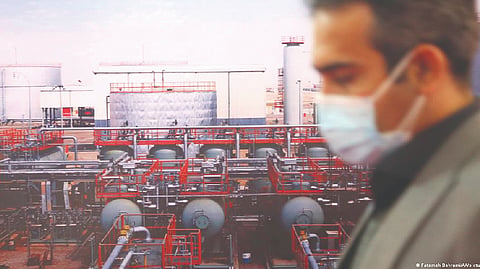

WASHINGTON: Iran’s crude oil exports have been surging in recent months on the back of higher shipments to countries like China, according to data from companies that track the flows. Analytics firms like Vortexa, TankerTrackers and Kpler estimate an increase in Iranian crude and condensate exports over the past three months, averaging around 1 million barrels per day.
The numbers are far below the over 2.5 million barrels per day the Persian Gulf nation was exporting in early 2018 — before the Trump administration withdrew the US from the international nuclear deal with Tehran and imposed unilateral sanctions — but they are much higher than those at times during 2020 when exports fell to less than 500,000 barrels per day. The surge comes despite stringent US sanctions, prompting some energy market analysts to speculate that Washington is not enforcing the restrictions strictly in an attempt to keep global crude prices in check. “It might be that the Americans are turning somewhat of a blind eye because they are happy to have as many more barrels on the market to help displace Russian oil,” said Thomas O’Donnell, a Berlin-based energy analyst. US officials, however, reject such claims. Robert Malley, the Biden administration’s special envoy for Iran, told Bloomberg last week that the US was not fine with increasing Iranian oil exports and that they would do “everything in our power” to enforce the sanctions.
Saying that “China is the main destination of illicit exports by Iran,” Malley stressed Washington would put pressure on Beijing to stop buying Iranian oil. O’Donnell said a lot of Iranian oil shipments appear to be heading to China via Malaysia, where it’s mixed with other blends and relabelled to conceal its original source. “A lot of both Venezuelan and Iranian oil goes to Malaysia and it’s not for domestic consumption. It goes there and it gets mixed to hide its origin,” he noted.
“It’s well beyond anything that Malaysia can produce so it’s probably Iranian oil and some Venezuelan oil coming in, being mixed and relabelled. And apparently, a good amount of it is going to China.” The US Energy Information Administration (EIA) also noted this trend. “According to industry analysts, much of the oil that was shipped from Iran to China was relabelled from countries such as Malaysia, the United Arab Emirates, and Oman to escape detection from customs authorities,” it said.
Henry Rome, a senior fellow at the Washington Institute for Near East Policy, said that the US would need to think creatively and adjust its priorities with countries like China and the UAE if it wants to see lower exports of Iranian oil. It has “a diplomatic cost,” he noted, adding that turning up the heat on Tehran “could also provoke an Iranian asymmetric response, and there may well be skepticism in the Biden administration that this added pressure would be all that productive.”
“Finally, it could lead to higher oil prices, although this is less of a concern today than it was over the summer.” Iran, a major producer of hydrocarbons, holds some of the world’s largest deposits of oil and natural gas. The nation’s crude oil production, however, has fallen since 2017 because of years of international sanctions as well as underinvestment. The EIA estimates that if sanctions were lifted, production could return to full capacity — around 3.7 million barrels per day.
But O’Donnell said Iran would face significant challenges to raise production even if a new nuclear deal were in place.
Visit news.dtnext.in to explore our interactive epaper!
Download the DT Next app for more exciting features!
Click here for iOS
Click here for Android